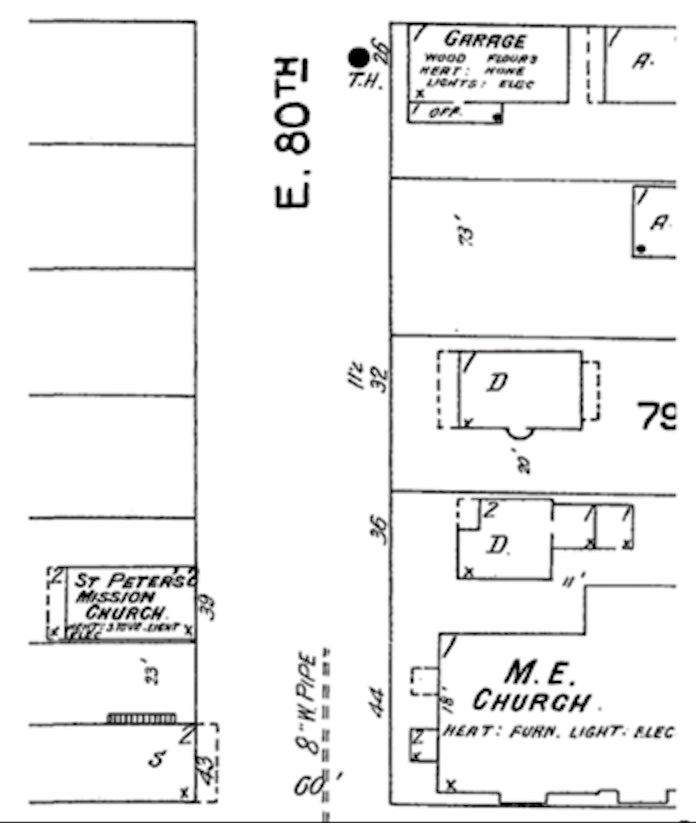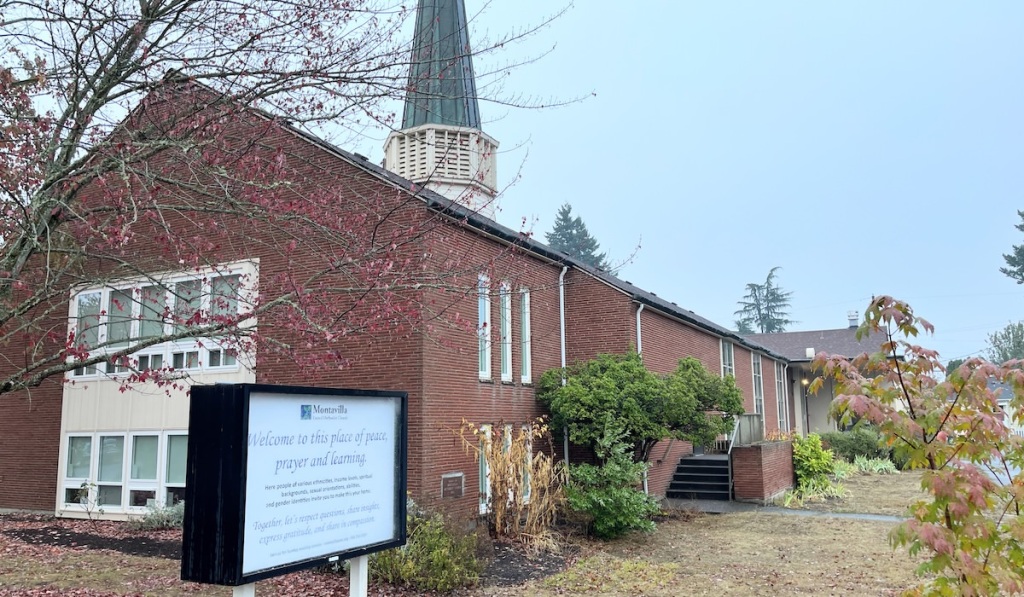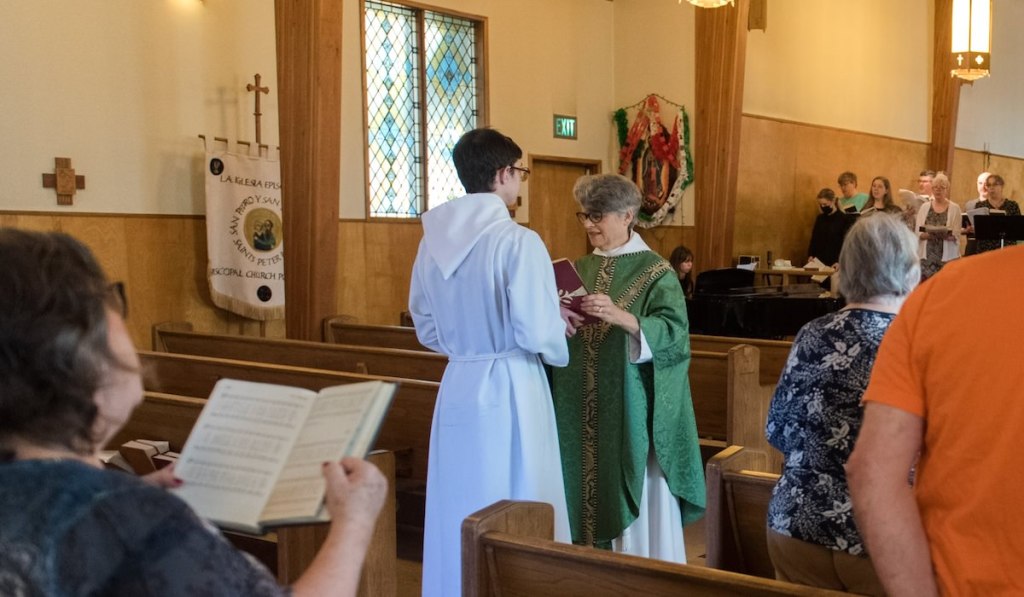Long a Montavilla landmark, the historic Saints Peter and Paul Episcopal Church is slated to be demolished to make room for a much-needed affordable housing complex.
The Montavilla church became known as Saints Peter and Paul only in 1968, when the congregations of the Montavilla church, St. Peter’s, merged with the Lents church, St. Paul’s. But the history of the Montavilla church goes back more than 100 years.
At its beginning, there was no church building, but the congregation had existed since at least 1915. At that time, Montavilla’s tiny Episcopalian community of some ten families gathered in homes or rented spaces. By 1920, they were an official mission church thanks to the assistance of Rev. Thomas Jenkins, rector of St. David’s in Portland.
Rev. Jenkins was dedicated to making Episcopal churches available to suburban communities. St. Peter’s was one of three mission churches he established in eastern Portland. Only St. Peter’s Chapel, as it was then called, survived and in 1926, got its own church building. When the congregation built a larger church in 1959, the original church was renamed Jenkins’ Hall in his honor.

But being designated a mission church did not necessarily come with a church building. The Montavilla congregation had to continue worshipping in rented spaces until it built a church in 1926. Until then, they were frequently forced to move as their rental spaces were sold. In 1920 and 1921 alone, they relocated five times.
Nor did a mission church come with a permanent priest. Sometimes, a visiting priest would conduct Sunday services, but sometimes, congregants like Dorcas Hallum and Ernest Stockley took the pulpit.

In 1926, the St. Peter’s congregation took out a loan and erected its own church at the corner of Pine Street and 82nd Avenue. Despite its small size, it was designed by the prestigious Portland architectural firm headed by Ellis F. Lawrence, founder and dean of the University of Oregon School of Architecture, and so many years later, it became an official historical landmark.
On Sunday, September 12, 1926, the St. Peter’s congregation processed from their rented quarters on 80th to the church site at the corner of 82nd and Pine for the groundbreaking ceremony.

Archdeacon Jay Claud Black officiated the first service on November 14, 1926. On November 18, the new church held an open house with the Women’s Guild hosting an afternoon tea followed by an evening of entertainment and a dance.

During the Depression, St. Peter’s had a series of temporary priests, so much of the church operation was still up to members of the congregation. They paid off the church mortgage in 1930 and soon after built a social hall. Unfortunately, at one point, the church coffers were so low that parishioners Mark and Ethel Francklin paid the priest’s salary.
During the 1940s, the congregation continued to be led by temporary priests. Then, in 1950, it got its first permanent priest: Rev. Kent Lambert Haley, who served St. Peter’s for the next 16 years. When he retired at the end of 1966, he left a legacy of remarkable accomplishments, including a new and larger church.

Rev. Haley had arrived in Portland just one year earlier, fresh from divinity school in Berkeley, California. His first posting was at St. Mark’s Episcopal Church, where he was also ordained as a priest. In 1950, Bishop Benjamin Dagwell urged Haley to take charge of St. Peter’s.
When he arrived in Montavilla, he found a rundown church surrounded by weeds. Rev. Haley’s daughter Mary still remembers playing in those weeds.
The church was located at the edge of Portland’s dense suburbs. 82nd Avenue was still a two-lane road, with farms, orchards, and nurseries to the east. At first, Rev. Haley, his wife Janice, and baby Mary had to live in a vicarage on 86th Avenue with a leaky roof and a crumbling basement.
During his 16 years at St. Peter’s, Haley spurred himself and his congregants into a flurry of activity. They helped with new building projects, maintaining and repairing the church building and grounds, organizing social events, and raising funds to cover expanding parish expenses.
Haley deeply loved church music, which would be a focus during his years as St. Peter’s priest. His masters’ thesis was on the boy choir in the parish church, and establishing a boys’ choir was a priority. He had directed boys’ choirs at St. Clement’s in Berkeley and St. Mark’s in Portland. In 1950, he created a boys’ choir at St. Peter’s. Around 1955, Haley added a girls’ choir.
Haley also introduced the medieval custom of the Boy Bishop, a practice he had revived in 1948 at St. Clement’s.

Every year on St. Nicholas Day, December 6, the choir elected one of its choristers to serve as Boy Bishop until Epiphany, January 6. The Bishop of Oregon installed the Boy Bishop, who would wear boy-size vestments and carry a bishop’s cross (crosier). He had various duties, including managing the choir, giving sermons, and leading processions. The last Boy Bishop was elected in 1965, Rev. Haley’s last year at St. Peter’s.
Other aspects of church life were improved under Rev. Haley’s leadership with the enthusiastic support of his membership.
In 1953 and 1954, the hall next to the church and the basement were enlarged. A new kitchen was added.
In 1955, St. Peter’s became an official parish, and Father Haley was instituted as its rector.
You would think, with all this activity on top of his religious duties, Haley would be pressed for time. But in 1954, he launched a children’s television show called “Noah’s Ark” on a local station. He told stories with his own drawings, just as he did for his Sunday school classes. The show ran weekly until 1957.

By 1956, St. Peter’s membership needed a bigger church, so the parish bought the vacant lots just west of the church. They also purchased the lot and house next door on Ash Street to serve as a new vicarage.
In 1958, the architectural firm of Dukehart and Kinne was hired to design a church that would seat 200 congregants and 50 choristers. St. Peter’s parishioner, Robert Kyle, oversaw the construction.
Groundbreaking occurred on November 30, 1958, and the new church was dedicated on November 27, 1959.

Father Haley wanted—and got—a traditional church design. He wanted architecture that reflected Anglican High Church traditions.
Father Haley described himself as an Anglo Catholic—or High Church—priest to distinguish Episcopalians from Protestants. In 1955, the Oregon Episcopal Convention dropped the word Protestant from the name of the Episcopal Church to stress continuity with traditional Roman Catholic practices. Haley was not happy when, in 1976, the national Episcopal Church reversed its position.
Besides getting a traditional Anglican church design, Rev. Haley argued for a pipe organ to provide a richer, smoother sound. A pipe organ was vastly more expensive, but fortunately, Bishop Benjamin Dagwell donated a Wicks pipe organ. The pipe organ needed its own room, but parishioners agreed to this added building expense. The church’s interior was designed with optimal acoustics in mind: lots of flat, smooth surfaces, including floors without carpets.


While church membership grew in the 1950s, it declined in the 1960s. In 1968, the Oregon Diocesan leaders recommended that it merge with another low-population church, St. Paul’s in Lents. The congregations agreed and the two churches became Sts. Peter and Paul. St. Paul’s rector, Rev. Lee H. Young, headed the combined church until 1977.
Under Rev. Scott H. Helferty, 1984-1994, Sts. Peter and Paul began programs to serve local communities in need, which had multiplied in the 1980s. Due to various economic and political conditions, there was a crisis of homelessness. Churches began programs to provide shelter and food.
Rev. Helferty and his parish began offering free dinners on Wednesdays to low-income and homeless people. So successful was this program that, in 1993, the Montavilla Business Association gave its Outstanding Citizen award to long-term parishioner Douglas M. Parker for his contribution to the program. The meal service continued as Brigid’s Table.
In subsequent years, under rectors Kurt Neilson, Sara Fischer, and others, new services were added. These services include Rahab’s Sisters, the Crisis Kitchen, the Red Wagon Project, and the Montavilla Wellness Fair.
Rahab’s Sisters was started in 2003 by a group of Episcopal lay and clergy women. It was inspired by the Maze Marigold project in London’s East End, which Rev. Fischer had observed firsthand in 2002. Rahab’s Sisters emulated the London project, offering non-judgmental hospitality to marginalized women and gender-diverse individuals in east Portland. Desiree Eden Ocampo, executive director of the project, refers to the service as harm reduction.

Beginning in 2011, Sts. Peter and Paul also reached out to Montavilla’s growing Latino community by offering Spanish language services, where visitors were welcomed by familiar images of the Virgin of Guadalupe. Spanish services continued until COVID arrived in 2020 when all in-person gatherings ended at the church.
While Sts. Peter and Paul reached out to the homeless and the hungry, it was slower to welcome female clergy. Lay women had long served in church guilds, but the Episcopal Church was slow to accept women clerics. Women were officially allowed to become deacons in 1970 and to become priests in 1976. Yet at Sts. Peter and Paul, only three women have held clerical positions: Jannis Goold, a deacon in 1990; Rev. Eleanor Applewhite Terry, a part-time assisting priest from 2003 to 2004; and Rev. Sara Fischer, a priest from 2020 to the present.

Over the years, Montavilla’s Episcopalian church has had its ups and downs, but it survived and served its community for at least 123 years. Now, the congregation is making the ultimate sacrifice, the surrender of its worship and social spaces in the interest of serving those in greater need.
Fortunately, the church’s service-oriented parishioners and their allies will continue their community assistance work. Rahab’s Sisters will operate from its temporary home in the nearby Montavilla United Methodist Church while it seeks funding for a dedicated facility. A new initiative, the Montavilla Collective, explores ways to weave a wider web of connection. In addition, the Episcopal Diocese of Oregon will be seeding a new community, currently under the name St. Mary the Prophet, to minister to those in the Montavilla neighborhood and beyond who are not served by traditional churches. The Rev. Sara Fischer will lead this new mission initiative part-time beginning in 2024.
The St. Peter and Paul’s complex will soon be gone, but its spirit of service and generosity will live on.
Saints Peter and Paul Episcopal Church will hold their last traditional Sunday liturgy at 10 a.m. on December 3rd. A special deconsecration will occur later that day at 5 p.m. followed by dinner. The church community invites the public to attend one or both events held at 247 SE 82nd Avenue.





